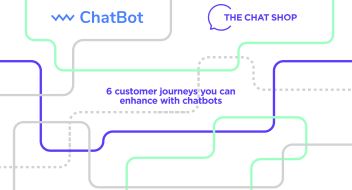Showing top 0 results 0 results found
Showing top 0 results 0 results found

Slow or inconsistent customer response times are a common challenge marketing teams face daily.
Automating customer interactions is key to avoiding situations where potential customers are left waiting for office hours or a human representative. For instance, when a customer visits your website with questions about a product or service, a chatbot can instantly provide relevant information, address frequently asked questions, or assist with specific pricing, availability, or features.
Since marketing chatbots are designed to handle multiple conversations simultaneously, they can offer immediate responses to inquiries—no matter the time of day.
Whether you're dealing with peak periods like product launches, holiday seasons, or marketing campaigns or simply need to respond to after-hours queries, marketing chatbots are an effective and reliable solution.
Read on to see how chatbots can improve your marketing efforts.
Start boosting your marketing with ChatBot today!
What are marketing chatbots?
Marketing chatbots are based on artificial intelligence or rule-based assistants designed to automate and enhance marketing tasks. By conversationally interacting with customers or prospects can instantly respond and guide users, reduce friction in the buyer journey, and lead to quicker decision-making, boosting sales and increasing overall customer experience.
Think of AI chatbots as digital sales reps or brand assistants available at all times on your ecommerce store, website, social media, or messaging apps to engage, convert, and support users.
Main purpose of using chatbots for marketing
Key strengths of utilizing chatbot marketing strategy:
- Enhance customer engagement — no more waiting for a real person to reply.
- Guide potential customers through the sales process — ask questions, recommend products, offer promotions.
- Increase qualified leads — collect emails, phone numbers, or preferences.
- Customer support campaigns — deliver offers, run quizzes, or share content.
- Automate follow-ups — send reminders or cart recovery messages.
Conversational AI chatbots instantly engage website visitors, providing a personalized customer experience, reducing bounce rates, and increasing time spent on your site. They generate leads by asking targeted questions, ensuring only high-intent prospects reach your sales team.
AI chatbots personalize product recommendations, making users feel understood with a practically human conversation. They automate repetitive tasks like answering FAQs or booking appointments, saving time for your team and allowing your human resources to engage in other tasks.
Virtual assistants help recover abandoned carts by sending reminders to customers and your sales team through messaging apps and emails. They can also run promotions, contests, and surveys to increase engagement and brand awareness.
Chatbots provide 24/7 customer support and can handle multiple conversations simultaneously, improving satisfaction and retention. They gather valuable customer feedback on behavior and preferences that inform future campaigns.
How chatbots for marketing work
Chatbots for marketing work by initiating conversations with users on platforms like Facebook Messenger, WhatsApp, websites, or SMS. Some chatbot platforms offer scripted conversations (rule-based flows) or AI-driven conversations (learn from data). They use predefined scripts or AI to understand user input and respond in a natural, helpful, and human-like way.
When visitors land on your site, a virtual assistant can greet them, offer assistance, or guide them toward relevant products or services. It can collect lead information like name, email, or preferences by asking simple questions. Some chatbot marketing examples (like ChatBot) can also capture customer queries or more complex queries to forward them to a support or sales team.
Chatbots can deliver personalized content, recommend products, or offer discount codes to boost engagement and conversions. Some customer service chatbots are integrated with CRM or email platforms to nurture leads through automated follow-ups.
Chatbots can re-engage customer interactions with customers who leave items in their carts or haven’t returned them. They also collect data from conversations, helping marketers understand audience behavior and improve campaigns.
Ultimately, chatbots streamline and enhance the customer journey by offering instant, interactive experiences. Let's see how to use them to the fullest.
How to use chatbots in marketing strategy
When used strategically, chatbots can be a game-changer in marketing. They help businesses gather diverse customer insights as interactions across channels reveal unique behavior patterns. You can build stronger brand presence and trust.
Here's a breakdown of how to use chatbots effectively:
- Customer engagement
- Lead generation
- Promotions and campaigns
- Data collection and insights
- Sales support and product recommendations
- Post-sale support
Customer engagement
- Keep users engaged through interactive content like quizzes, polls, or games
- Offer personalized recommendations based on user behavior or answers
- Follow-up automatically if users don’t convert right away
Enhancing user engagement in a marketing strategy should be based on creating meaningful, interactive experiences. It helps to keep your audience interested and connected with your brand. This type of engagement feels more personal and dynamic, which helps build stronger relationships and trust with your audience.
Conversational AI chatbots can be programmed to greet returning visitors by name, remember past interactions, and suggest relevant content or products based on previous behavior. Giving users a more personalized customer experience makes them feel seen and valued, encouraging them to stay longer, click deeper, and return more often.
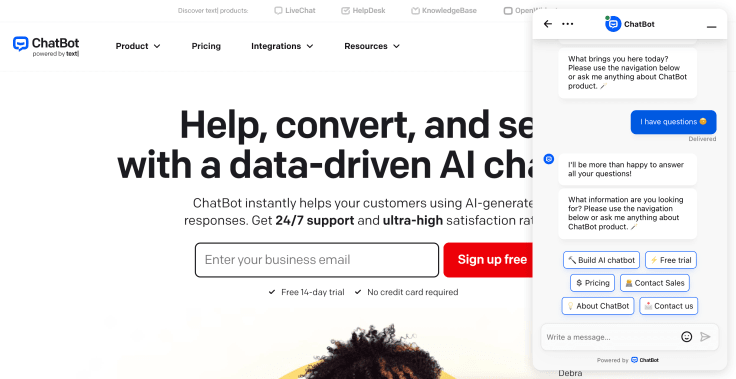
Chatbots can also be used to share updates, promotions, or new content in a conversational tone, making your messages feel less like marketing and more like a helpful nudge. Engaging features like quizzes, polls, or even gamified experiences through chat can increase interaction, making your brand more memorable and fun for your growing customer base.
Moreover, some chatbot marketing examples can act as guides throughout the customer journey, helping users navigate your site, compare products, or even complete purchases without leaving the conversation.
Lead generation
- Engage visitors with a marketing chatbot instantly on your website or social platforms
- Ask qualifying questions to segment leads with artificial intelligence
- Capture emails or contact info in a friendly, conversational way
Using AI chatbots for lead generation within a marketing strategy is about creating a smooth, conversational path that guides potential customers toward sharing their information and expressing interest in your offer.
Instead of relying on static forms or waiting for someone to reach out, conversational AI takes the initiative by engaging visitors when they arrive on your ecommerce store, website, Facebook page, or other messaging platform. As users respond, the chatbot gathers data and qualifies leads based on user inputs.
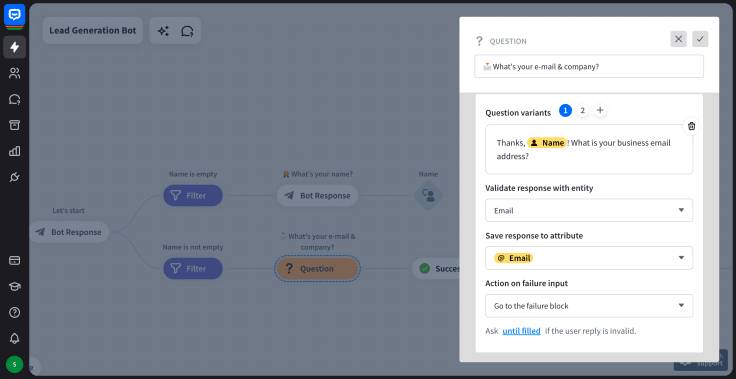
Throughout this interaction, the chatbot can offer value in exchange for contact details—such as a free consultation, a discount code, or access to an exclusive resource like an ebook or webinar. Once the lead is captured, the chatbot can automatically pass the information to your CRM or email marketing system.
Over time, the chatbot also gathers data on user behavior and common questions, giving user feedback on improving your messaging or offers.
Promotions and campaigns
- Use bots in marketing campaigns to send offers, coupon codes, or time-sensitive deals
- Run contests, giveaways, or referral programs through conversational AI flows
- Deliver updates (new products, events, launches) in real-time using a chatbot
A marketing chatbot adds an interactive layer to your outreach that feels personal and immediate. AI chatbots allow you to deliver promotional messages in real-time through multiple conversations directly to your audience through channels they’re already active on—like your website, Facebook Messenger, Instagram, or WhatsApp.
When potential customer interacts with your AI chatbot during a campaign, you can automate responses to guide them through a tailored conversation that highlights the offer, answers their questions, and leads them straight to the checkout page or sign-up form.
A good use of chatbot marketing can also help build hype before a campaign by collecting sign-ups for early access or exclusive deals. This keeps people excited and engaged leading up to the big release.
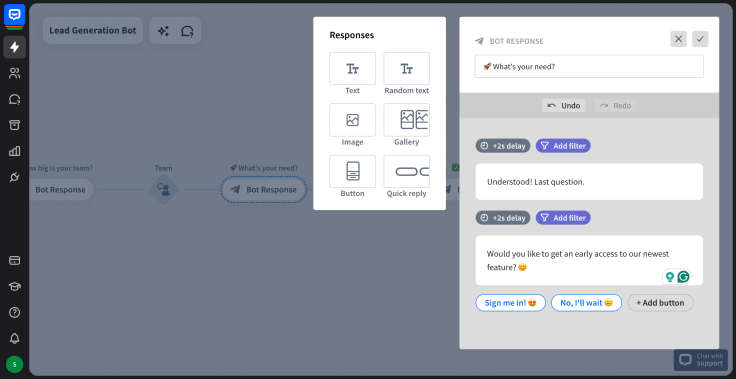
Generative AI also makes it easier to personalize marketing messages based on a user’s past interactions or preferences, so each person gets a message that actually resonates with them. After a campaign, and effective chatbot can follow up with customers to gather feedback, suggest related products, or invite them to the next event.
Data collection and insights
- Collect user feedback, preferences, and behavior for better targeting
- Use chatbot conversations to identify pain points in your chatbot strategy
- Feed data into your analytics to improve your bot marketing
A properly designed chatbot marketing lets you learn about your customer’s preferences and behaviors by asking customer service questions while interacting with your brand's marketing chatbot. These user interactions can be designed to feel effortless for users, making them more keen to share honest user inputs.
As website visitors engage with your marketing chatbot, it can automatically log answers while guiding users through sales and support processes. This creates a rich source of first-party data that helps you understand who your customers really are and what they want.
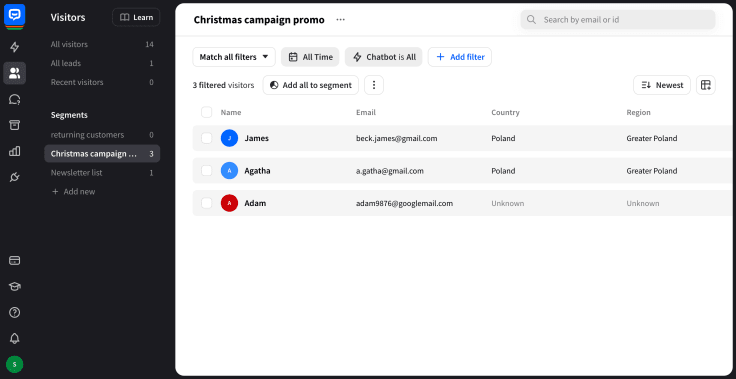
Over time, machine learning algorithms can identify common patterns, such as which products are most frequently asked about, what objections people raise before purchasing, or where users tend to drop off in the funnel.
The data collected during chats can be used in further processes. With a seamless integration with your CRM or analytics tools, you can refine your customer base. The insights gathered from customer queries can help you make smarter decisions that lead to more effective chatbot marketing strategies.
Sales support and product recommendations
- Use bot marketing to recommend products based on user preferences
- Help users navigate your store, find items, or even upsell using chatbot
- Integrate with CRMs or e-commerce platforms for smooth conversions
When your website visitors or messaging app users engage with your marketing chatbot, it can act like a virtual assistant—asking what they’re looking for, what problems they’re trying to solve, or their preferences. It ensures that support and guidance are available 24/7, which is especially valuable for businesses with international customers or outside of normal working hours. This increases loyalty and your brand's image.
Based on the answers, marketing chatbots can instantly give personalized recommendations or services that match the customer’s needs, helping speed up decision-making and keeping the buying process smooth.
This approach boosts sales and makes customers feel understood and supported by the chatbot without speaking to a real person. Generative AI can handle common sales-related questions, and if a user seems hesitant or needs more information, it can provide it with its natural language processing capabilities.

AI agents are also great for cross-selling and upselling. They can recommend complementary items or higher-tier products based on what’s already collected during the chat or in the user’s cart.
Post-sale support
- Automate FAQs, order tracking, returns, or appointment scheduling with chatbot marketing
- Reduce support costs while increasing customer satisfaction
- Offer 24/7 service without hiring more reps
After purchase, a chatbot can immediately follow up with the customer support process to confirm the order, provide tracking information, and answer common questions about delivery times or return policies. This instant communication reassures the buyer across all your marketing channels and reduces the need to contact customer service directly.
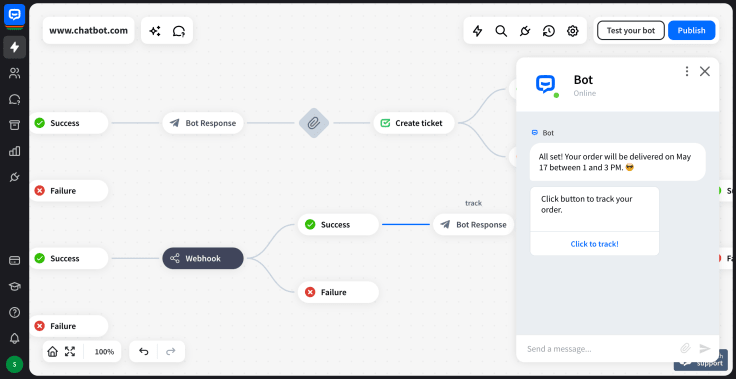
Increasing generative AI usage in your marketing campaigns means the chatbot can help troubleshoot problems, offer solutions, or escalate the conversation to a human agent when needed. Chatbot can also assist users through return or exchange processes, making those experiences smoother and less frustrating.
You can create a chatbot that proactively engages with customers after their purchase by checking in on their satisfaction, collecting customer and customer feedback, or suggesting helpful content related to their product.
Chatbots can also use past purchase data to offer personalized marketing messages or exclusive offers, subtly increasing your brand's image.
Popular channels for chatbot marketing
Customers today expect fast, seamless interactions, and being present on different platforms increases your chances of capturing their attention and engaging them effectively. It also ensures that no matter how someone finds your brand—through an ad, a Google search, or a referral—they receive consistent support and messaging from the chatbot.
Multi-channel chatbot marketing boosts accessibility, making it easy for customers to ask questions, get recommendations, or purchase from their preferred platform.
Website (e.g., ChatBot)
The most common place to create a chatbot is a webpage. They allow businesses to engage website visitors when they land on a page. A good chatbot marketing on websites can greet users, answer questions, offer product recommendations, or generate lead information, all in real-time.
As most customers research products online before deciding, having a chatbot here ensures you don’t miss the chance to guide and convert them on the spot.
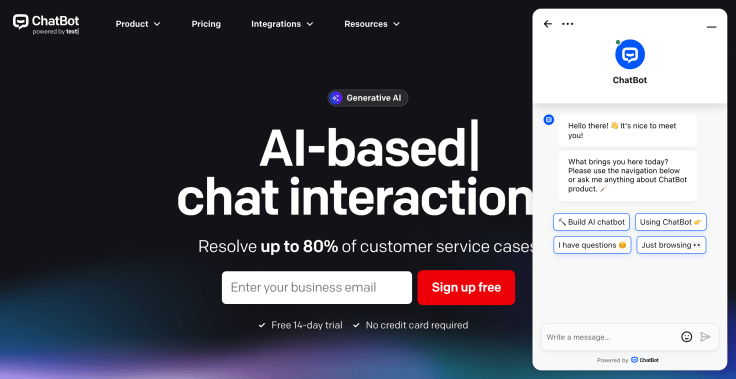
Social media
Facebook Messenger
Facebook's global user base and integration with Facebook Ads result in bots on Messenger that can instantly engage users who click on ads, walk them through product options, deliver content, or even process orders—creating a highly interactive and personalized marketing experience.
Since Facebook Messenger is a familiar platform for many users, potential customers are likelier to interact without hesitation.

Using a chatbot for marketing purposes on Instagram helps you engage with followers instantly and at scale, even when you're not online. Instagram users often reach out through DMs, comments, or story replies, and an AI chatbot ensures they get fast, helpful responses without delay. This improves the user experience and increases the chances of converting casual browsers into leads or customers.
When used strategically, an Instagram generative AI can make your brand more responsive, interactive, and effective at turning engagement into results.
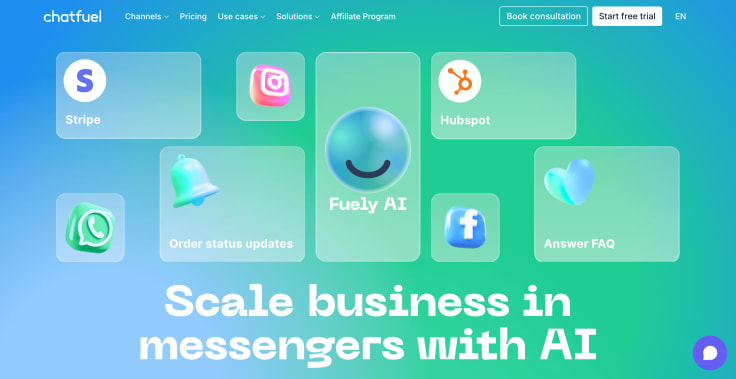
WhatsApp is becoming popular for chatbot marketing due to its widespread use in personal communication. Businesses can use WhatsApp chatbot providers to send updates, nurture leads, provide customer support, or deliver promotional messages directly into the user’s inbox.
Its high open and response rates make it ideal for time-sensitive campaigns and building closer, trust-based customer relationships.
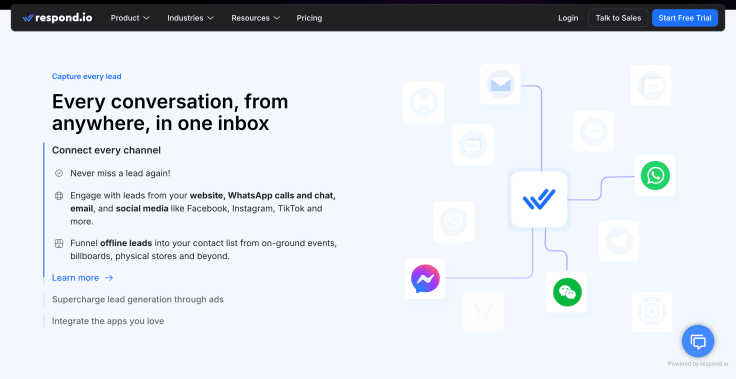
Instead of sending potential customers to static landing pages in your marketing campaigns, you can direct them to a marketing chatbot that continues the conversation in real-time. This creates smoother customer interactions, increasing the chances of converting interest into action. Strategic chatbot marketing can qualify leads immediately after someone clicks a link in your email.
Combining email's reach with natural language processing's interactivity, your chatbots boost sales rates and reduce drop-offs.
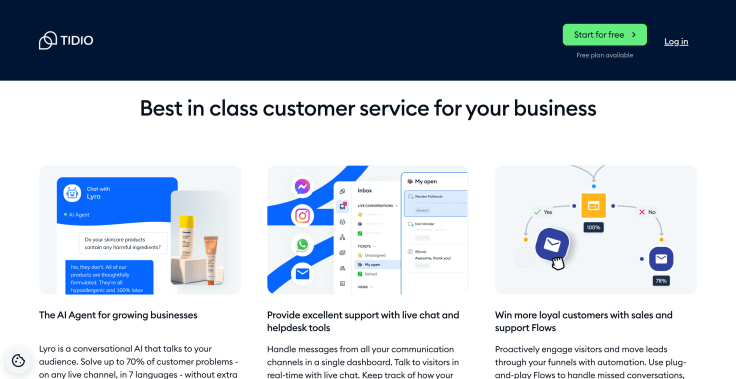
Examples of marketing chatbot use
Numerous companies worldwide have incorporated chatbots into their marketing processes. The boost in sales, support, and overall business is unmatched.
Wembley Stadium and ChatBot
The AI-powered frontline of the ChatBot marketing chatbot helped Wembley Stadium earn over $1.5M in eight months. Located in London and owned by the Football Association, it symbolizes British live sports and entertainment.
Our sales process was reliant on telephony. After we implemented ChatBot and LiveChat, we were able to remove the phone number from our website and reduce the number of non-sales-related calls.
They use ChatBots' conversation flows to speed up resolution time, increase customer satisfaction, and optimize the customer journey. During each hosted event, many support tickets land in their help desk system. The marketing chatbot helps them manage the tickets and up to 12k monthly chats.
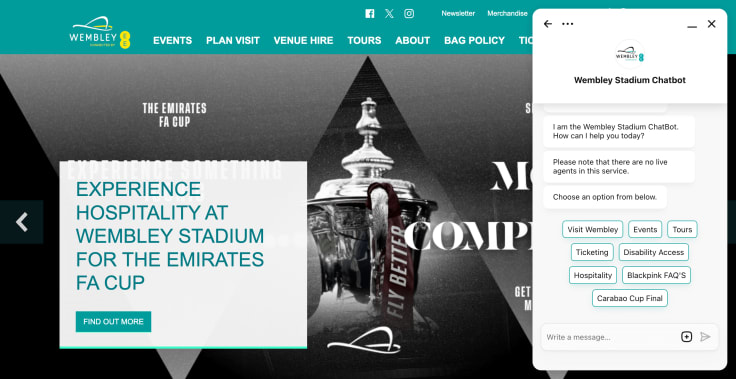
With 90,000 seats at the stadium arena, the team must address many questions, including ticket availability, hospitality options, accessibility, merchandise, and more.
Hairlust and ChatBot
With 13 locations and up to 800k monthly visitors, they save 20% of their communication time using ChatBot's bot. Since 2017, Hairlust has been at the forefront of the direct-to-consumer revolution, using social media and influencer marketing to build authentic, personal relationships with shoppers.
By integrating ChatBot, we hoped to work more efficiently in our customer service and offer our customers a better experience with fewer back-and-forth emails.
Hairlust manages most customer service inquiries on the contact page and social media channels using ChatBot. They redirect users with auto-replies to their landing page using a drag-and-drop, user-friendly visual builder that requires no coding skills.
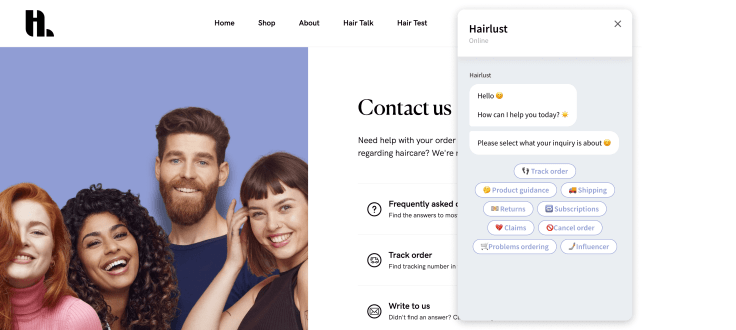
Such a conversation flow setup lets the Hairlust team focus on more creative and mundane tasks. Consolidating customer inquiries helps Hairlust manage and use qualified leads quickly and more accurately, creating a consistent support experience.
Allbirds and Zendesk
Allbirds, renowned for its sustainable footwear and apparel, emphasizes delivering exceptional customer experiences. Customers can engage with Allbirds' support team via their website's chat feature.

Zendesk enables its support team to handle approximately 3,000 weekly email and social media inquiries, ensuring prompt and personalized responses. By utilizing Zendesk's tools, such as macros for frequently asked questions and integration with Shopify for order-related information, Allbirds streamlines its customer service processes.
IKEA'S Billie
IKEA developed a chatbot named Billie, an AI-powered virtual assistant available 24/7. It is designed to assist customers with various inquiries, such as order tracking, store hours, delivery rescheduling, and reporting missing or damaged items. The chatbot is available on a contact page, demonstrating IKEA's commitment to leveraging AI chatbot technology to improve engagement and streamline the shopping experience.
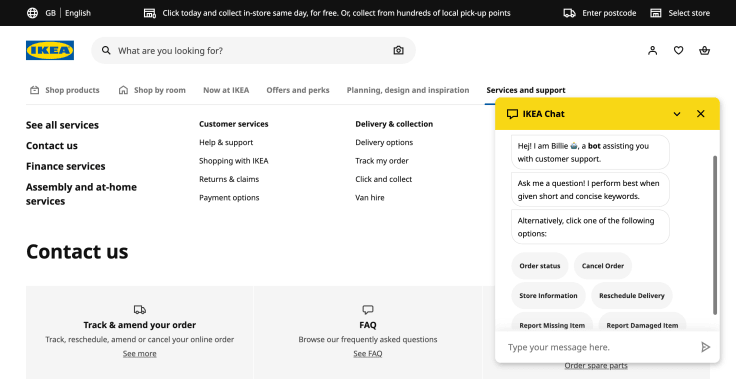
Since its rollout in 2021, Billie has handled approximately 47% of customer inquiries, equating to around 3.2 million interactions and resulting in nearly €13 million in savings. By managing routine queries, Billie allows human co-workers to focus on more complex customer needs.
How to incorporate ChaBot in your marketing strategy
Incorporating ChatBot into your company strategy can significantly enhance customer satisfaction, automate lead generation, and boost conversions.
Use ChatBot to greet visitors on your website, offer assistance, or guide them toward the right product or service. For first-time visitors, you can set up chatbot flows to capture emails in exchange for discounts or downloadable resources, helping grow your email list.
Here’s how you can strategically implement it.
1. Identify key touchpoints in your customer journey where a chatbot can add value- this includes your website, landing pages, product pages, and even your blog.
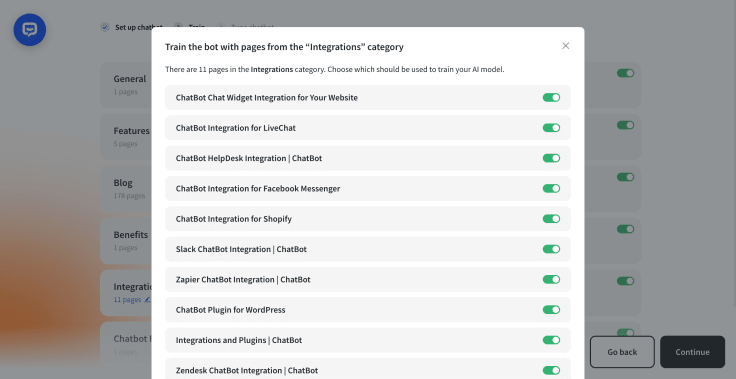
2. Use an automated method for creating chatbots. Provide your website's URL address. The AI model will scan the page and create a bot flow based on the provided information.
3. See the scanned knowledge sources in the built-in knowledge base.

4. Adjust the conversational flows to qualify leads in real-time, ask questions about industry, budget, or project needs, and then pass hot leads directly to your sales team or schedule a demo with Zapier or webhooks integrations.

5. If you’re running campaigns, use the chatbot to support promotions, deliver time-sensitive offers, or follow up on ad clicks through channels like Messenger or Shopify.
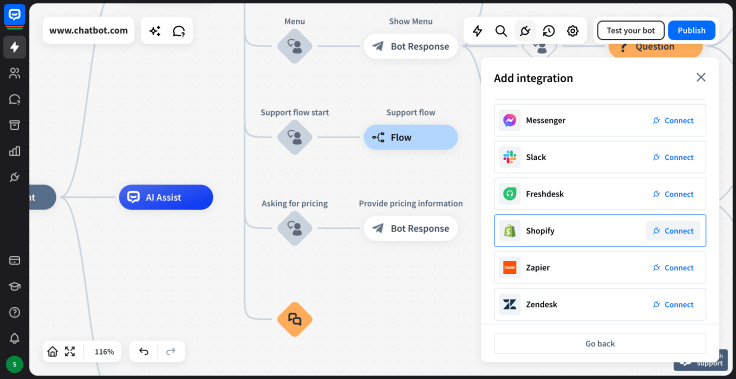
6. Existing customers can use the chatbot for post-sale engagement, such as order tracking, collecting feedback, or recommending related products with integrations with Shopify and more.
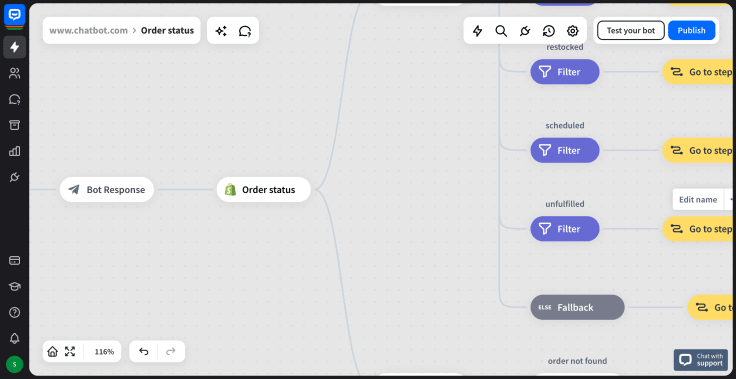
7. ChatBot's Reports dashboard will also help you track interactions, measure engagement, and optimize flows based on user behavior.
To maximize impact, integrate the chatbot with your CRM, ecommerce platform, or website to ensure your marketing data stays connected and actionable.
Conclusion
Conversational AI chatbots help businesses engage with customers instantly, automate lead gathering, and create personalized experiences while chatting with multiple users. They provide 24/7 support, answer common questions, and guide users through the sales processes—improving conversion rates and reducing the workload on your team.
Marketing chatbots also collect valuable customer insights, allowing you to better understand your audience and refine your campaigns. In a world where fast, interactive communication is expected, chatbots help brands stay responsive and competitive.
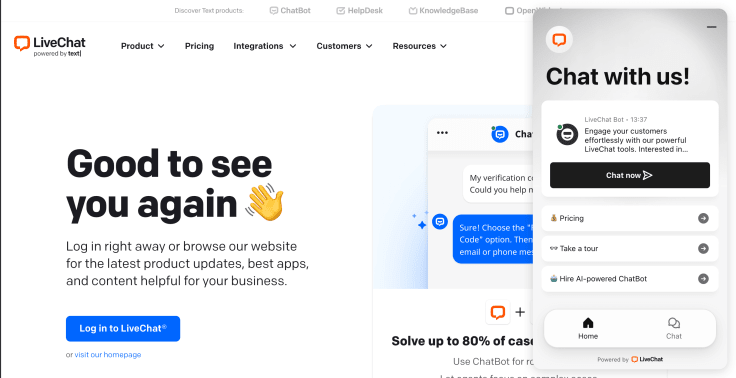
One of the best providers for implementing your own chatbot that can generate text is ChatBot. It offers an easy-to-use platform with user-friendly interface conversation builders, powerful integrations with tools like Messenger, WhatsApp, and LiveChat, and detailed analytics to track performance.
Start your free ChatBot trial now -
a 14-day free access to build and integrate your bot into your ecosystem.
Whether you're looking to capture leads, support customers, or drive sales, ChatBot is a reliable and scalable solution for modern marketing teams.
